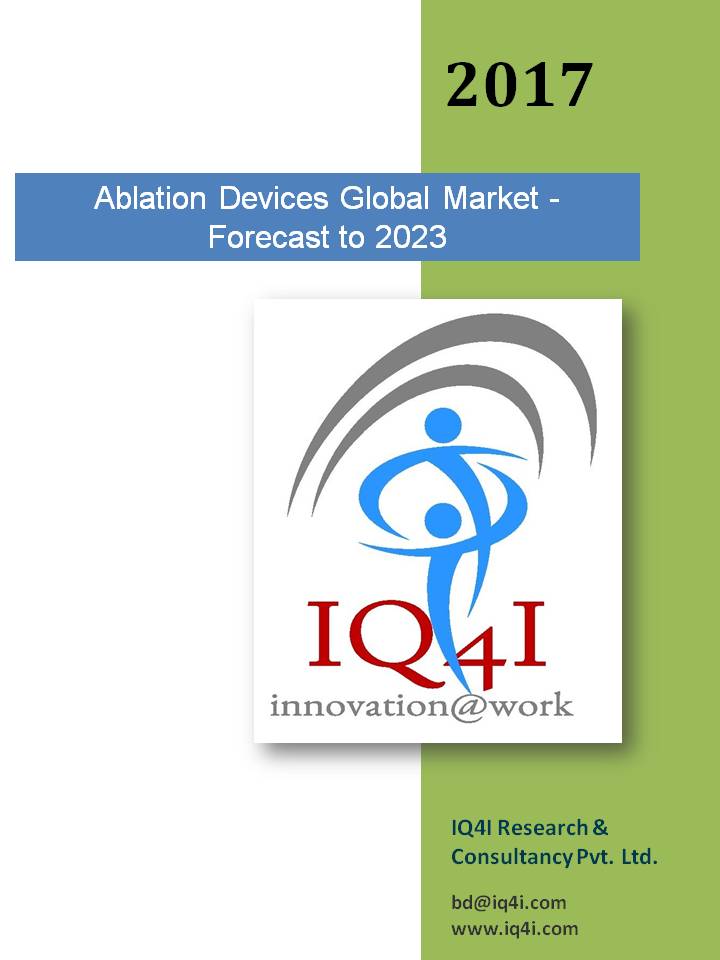
IQ4I Research & Consultancy published a new report on “Ablation Device Global Market – Forecast To 2023”

Ablation is a procedure to remove tissue surgically or MIS. Increasing number of ablation procedures, rising incidence of cancer is driving the market.
BOSTON , MASSACHUSETTS, U.S., April 26, 2018 /EINPresswire.com/ -- Ablation is a process of tissue removal by either minimally invasive procedures or through surgical procedures using thermal or non thermal technologies. The procedures date to as old as 1981, when the first catheter ablation was performed on humans for treating atrial fibrillation. Since then ablation technology have grown over time and have emerged as more sophisticated, easy to use next-generation devices for treating conditions such as cancer, pain, epilepsy, eye disorders, cosmetic skin corrections, abnormal uterine bleeding, hypertension, benign prostatic hyperplasia, Barret’s oesophagus and asthma. Ablation technology sorts are generally differentiated based on the type of energy utilized. These include laser, radiation, radiofrequency, ultrasound, freeing cold temperature, chemical, hydrothermal, microwave, and mechanical.
The ablation device global market is expected to grow at the high single digit CAGR due to the increase in the incidence of cardiac diseases. According to IQ4I Analysis, the ablation device global market is valued at $11,766.6 million in 2016 and is expected to reach $20,995.5 million by 2023. Increasing number of ablation procedures, rising incidence of cancer, an emergence of next-generation ablation products and technologies, growing adoption of minimally invasive procedures, and improving reimbursement scenario in established markets are some of the factors driving the market. However, reuse and reprocessing of devices in developing countries, healthcare cost-containment measures, stringent regulatory guidelines, and challenges in therapeutic procedures are some of the factors hampering the market.
Ablation devices are categorized based on the technology or the modality that is used to bring about ablation as thermal and non-thermal mode of ablation. Thermal technologies are further segmented into radiofrequency, freezing cold temperatures (Cryoablation), laser, microwave, radiation, ultrasound and hydrothermal energy. These ablation devices bring about heating of the tissue by using any one of the energy source and ablate the tissue. Non-thermal technologies include irreversible electroporation, mechanical and other modes of ablation (Chemical). Radiofrequency ablation has been the established standard, but cryoablation and microwave ablation technologies are soon set to out par the radiofrequency market and indicate high growth potential.
Many hybrid technologies are entering the market, and are expected to have a great position in future due to its dual mechanism capabilities. The Sonata (Sonography-Guided Transcervical Fibroid Ablation) System by Gynesonics is an advanced technology platform integrating miniaturized sonographic guidance with radiofrequency ablation in a single delivery system for transcervical treatment of a wide range of uterine fibroid types and sizes.
By application, the market is segmented into oncology, cardiovascular (atrial fibrillation, ventricular tachycardia, and others), ophthalmology, cosmetology, gynecology, urology, orthopedics, pain management and others. While the various ablation techniques make them flexible devices for use in an extensive variety of surgical methods, the highest utilization is witnessed in cancer therapy for the removal of cancerous tissue, followed by cardiovascular and then the general surgery applications. Similarly by end-users, the market is segmented into hospitals, ambulatory surgical centers, and specialty clinics and increased reimbursement facility is aiding for the growth of hospitals.
North America accounted for the largest share in the ablation device market and is estimated at in 2016. The existence of well established healthcare infrastructures utilizing sophisticated and advanced ablation technologies is responsible for high growth in this region. On the other hand, Asia Pacific region is expected to grow high with a double digit CAGR by 2023. The growth is attributed to increasing healthcare awareness among people for early diagnosis and rising government expenditure on healthcare services.
The key players in the ablation device global market include Boston Scientific Corporation (U.S.), Johnson and Johnson (U.S.), Abbott laboratories (St Jude Medical) (U.S.), Medtronic (Ireland), Stryker Corporation (U.S.), Elekta AB (Sweden), Olympus Corporation (Japan), ConMed Corporation (U.S.), Hologic (U.S.), Articure Inc. (U.S.), Angiodynamics Inc. (U.S.), Smith and Nephew plc (U.K.), and Varian Medical Systems (U.S.).
Other key players in the market are Halyard Health (U.S.), BTG PLC (U.S.), Insightec (Israel), EDAP Tms (France), SonaCare Medical (U.S) and Misonix (U.S.)
Mr. Satish Birudukota
IQ4I Research & Consultancy Pvt Ltd.,
+91-80-8147030229
email us here
EIN Presswire does not exercise editorial control over third-party content provided, uploaded, published, or distributed by users of EIN Presswire. We are a distributor, not a publisher, of 3rd party content. Such content may contain the views, opinions, statements, offers, and other material of the respective users, suppliers, participants, or authors.

